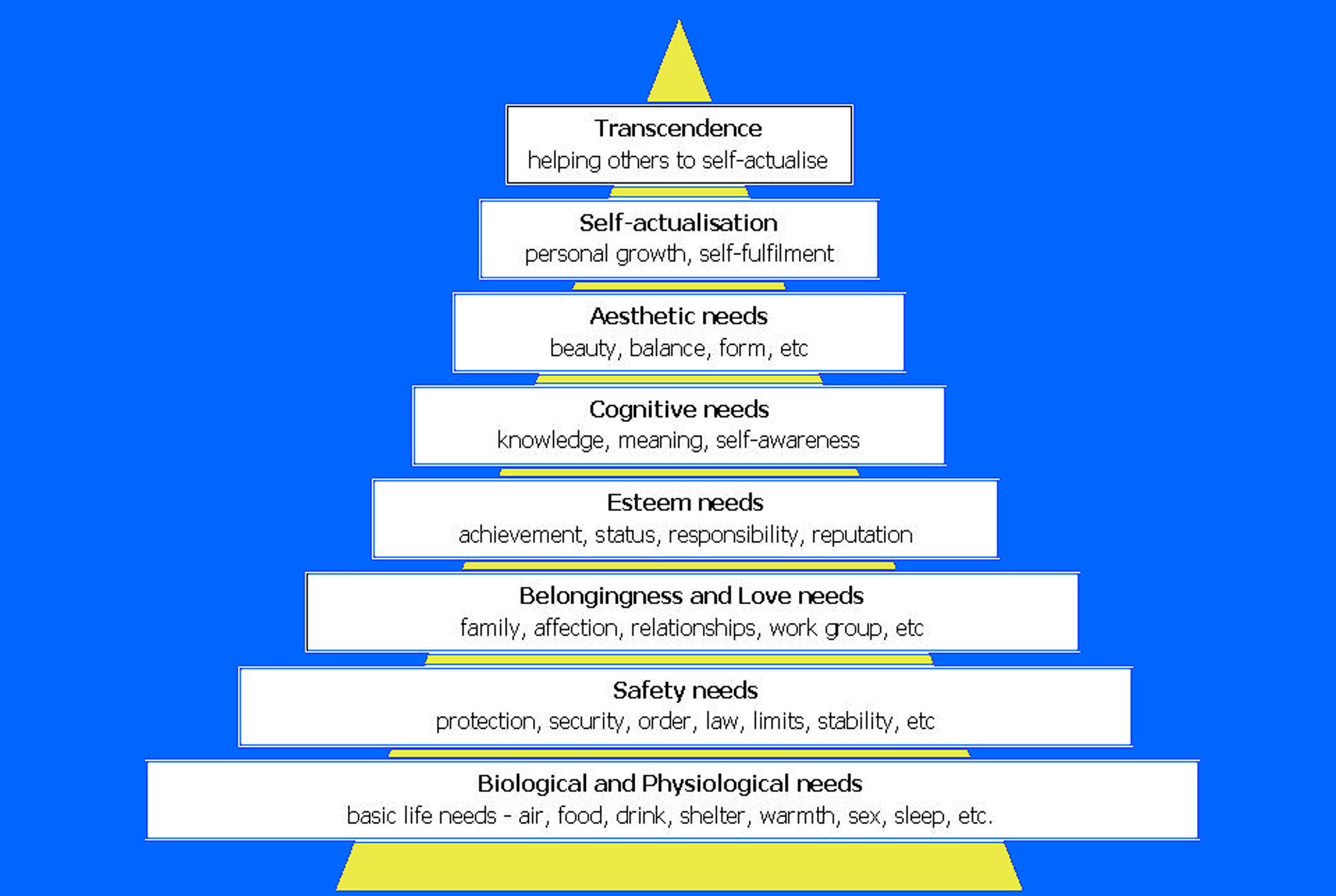MASLOW'S HIERARCHY OF NEEDS
Abraham Maslow was an American psychologist born in 1908 and he died in
1970. Maslow's primary contribution to psychology was rather than
focus on the negatives of what made some people psychologically sick
and how to make them better, he thought outside the psychological
box of the time. Maslow focused on psychological positives and
believed each of us has a strong desire to realize our full
human potential (what he termed becoming fully actualized). He
developed a psychological roadmap which he felt helped or
inhibited us from reaching personal self actualization.
In 1943, at the age of 35, Maslow was teaching at Brooklyn
College and he wrote a paper titled
A Theory of Human Motivation.
In the paper, he focused on trying to describe what motivates us as humans to
want to reach our full potential and the different stages of our psychological
development along that path. He felt our psychological growth toward
self-actualization was intrinsically tied to our basic human needs
and how well we mastered each of those needs. Over the next 11 years, he refined his
theory and presented it in full detail in his 1954 book which he titled
Motivation
and Personality.
Defining this basic human desire and the path to reach our full potential was really
Maslow's primary contribution to the field of psychology which eventually became known
as Maslow's Hierarchy of Needs and is most often displayed in the form of a triangle.
Maslow's Triangle

Maslow's original triangle had 5 levels of basic needs. He later further
delineated the hierarchy to include three other levels breaking our
human needs into 8 levels. He arranged them in a hierarchy such that
we are motivated primarily by a need only if the lower level needs
have been met. Thus before one feels compelled to address cognitive
and aesthetic needs, one needs to have taken care of things like
biological, safety, etc. needs. Also, one cannot transcend and help
others become self-actualized unless one has already become
personally self-actualized.
How To Interpret the Triangle
The triangular visual aid Maslow created to explain his theory,
which he coined Hierarchy of Needs, depicts the levels or steps of human,
psychological and physical needs human beings have to ascend to
reach self-actualization. Going from the bottom up:
- Basic Needs or Physiological Needs - these are
somewhat obvious and necessary for basic human survival. Without food,
air, drink, warmth and sleep, the human body cannot continue to
function.
- Safety Needs - Once physical needs are somewhat
satisfied, focus on safety needs take precedence and dominate our
behavior. These needs being satisfied quell our need for an orderly
predictable world where unfairness and inconsistency are under
control.
- Belongingness and the Need for Love - Once basic and safety
needs are met, human needs become social and involve a need
for acceptance and to love and be loved. If these elements are
absent, social anxiety and depression can arise.
- Esteem Needs - This level is is attained when
individuals feel comfortable with what they have accomplished
from a success and status standpoint.
- Cognitive Needs - At this point, we feel a need
to increase our intelligence and we chase knowledge to gain a better
understanding of the world around us. We now feel a need to explore
and desire new experiences.
- Aesthetic Needs - With the previous needs
satisfied, we now find we need to refresh ourselves with the
presence of beauty, nature, art, music and the other aesthetically
beautiful things the world has to offer. This leads to a beautiful
feeling of intimacy and oneness with nature and everything
beautiful.
- Self-actualization - This is our instinctual
need as humans to make the most of our abilities and to strive to be
the best we can be. Quoting Maslow "What a man can be, he must be."
It is also at this level that individuals experience extraordinary
moments called Peak Experiences which include transpersonal and
ecstatic states tinged with themes of euphoria, harmonization and
interconnectedness.
- Transcendence - Having personally
self-actualized, there is a desire to help others self-actualize. In
doing so, we connect with something beyond the ego and we experience
states beyond normal human consciousness and take things to another
level of being.
Some Additional Things to Consider
Maslow's depiction of human needs seems basic to all societies. However,
local societal programming and personal egos have a lot to do with
how much we feel is personally required of each need before we feel
motivated to reach for the next higher level need.
In Western societies, we tend to feel we require much more of the lower
level needs (food, shelter, clothing, objects, safety, love, accomplishments, status,
etc.) to be satisfied with those levels than individuals in Eastern societies.
Consequently, our Western egos and desires for more objects and
status often slow our progress toward self-actualization and
transcendence over our Eastern counterparts who do not place such
high premiums on lower level needs once those basics are provided.
In fact, being overly prosperous and status oriented are
often inhibitors to seeking and achieving self-actualization and
transcendence.




